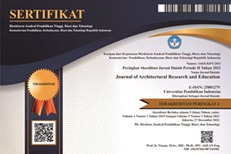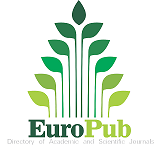Experimental Study of Adaptive Reuse on Bali Festival Park Building using Adaptive Reuse Potential Analysis (ARP) Method
Abstract
Keywords
Full Text:
PDFReferences
Aghaei, M.G., & Ramezani, M. (2018). Adaptive Reuse of industrial buildings: A literature review. Renewable and Sustainable Energy Reviews, 92, 669-679.
Alshamsi, A., & Kaka, H. (2017). Adaptive Reuse of heritage buildings: A review of design approaches and sustainability implications. Journal of Cleaner Production, 142, 3204-3217.
Bullen, P. A. (2004).” Sustainable adaptive re-use of the existing building stock in Western Australia”. Heriot Watt University. Association of Researchers in Construction Management, Vol. 2, 1387-97.
Cantell, S.F. (2005). “The Adaptive re-use of Historic Industrial Buildings: Regulation Barriers, Best Practices and Case Studies. Master of Urban and Regional Planning Thesis, Virginia Polytechnic Institute and State University.
Department of the Environment and Heritage (2004), Adaptive Reuse-Preserving our past, building our future, Commonwealth of Australia.
Gorse, C. & Highfield, D. (2009).” Refurbishment and Upgrading of Buildings”. New York : Spon Press. İdemen, E.A. , Acar, E. & Mert Şener, S. (2016). “Assessing the Adaptive Reuse Potential of Buildings as Part of the Disaster Management Process”.
Langston, C. and Shen, L.-Y. (2007) ‘Application of the Adaptive Reuse potential model in Hong Kong: A case study of lui seng chun’, International Journal of Strategic Property Management, 11(4), pp. 193–207. doi:10.3846/1648715x.2007.9637569.
Li, Y., & Zhang, X. (2020). Adaptive Reuse of abandoned buildings: A case study of the Shanghai World Financial Center. Sustainable Cities and Society, 54, 102198.
Musso, S.F., Kealy, L. and Fiorani, D. (2017) Conservation adaptation: Keeping alive the spirit of the place: Adaptive Reuse of heritage with symbolic value. Hasselt, Belgium: EAAE.
Onwuegbuzie, A.J. and Johnson, R.B. (2021) The Routledge Reviewer’s Guide to Mixed Methods Analysis [Preprint]. doi:10.4324/9780203729434.
Park, S. (2009) A design strategy for transforming an old power plant into a cultural center.
Ramezani, M., & Aghaei, M.G. (2021). Adaptive Reuse of abandoned industrial buildings: A review of design approaches and sustainability indicators. Renewable and Sustainable Energy Reviews, 137, 110381.
Rashid, M.A., Hasan, M.S., & Basri, S.M.A. (2019). Adaptive Reuse of historical buildings: A systematic review. Sustainability, 11(17), 4672.
Soewarno, N., Hidjaz, T. And Virdianti, E. (2017) ‘Adaptive Reuse as an effort to preserve an historical district: A case study of the braga corridor in the city centre of Bandung, Indonesia’, WIT Transactions on Ecology and the Environment, 1, pp. 89–100. doi:10.2495/sc170081.
Wilkinson. S.J. & Reed. R.G. (2008). “The Business Case for incorporating Sustainability in Office Buildings: The Adaptive re-use of Existing Buildings”. PRRES 2008: Investing in Sustainable Real Estate Environment: Proceedings of the 14th Annual Conference of the Pacific Rim Real Estate Society, Kuala Lumpur, Malaysia. Hal. 1-18.
Wilson C. A. (2010). Adaptive Reuse of Industrial Buildings in Toronto, Ontario Evaluating Criteria for Determining Building Selection, pp.38.
DOI: https://doi.org/10.17509/jare.v7i1.74763
Refbacks
- There are currently no refbacks.
Copyright (c) 2025 Journal of Architectural Research and Education

This work is licensed under a Creative Commons Attribution-NonCommercial-ShareAlike 4.0 International License.

This work is licensed under a Creative Commons Attribution-ShareAlike 4.0 International License.








